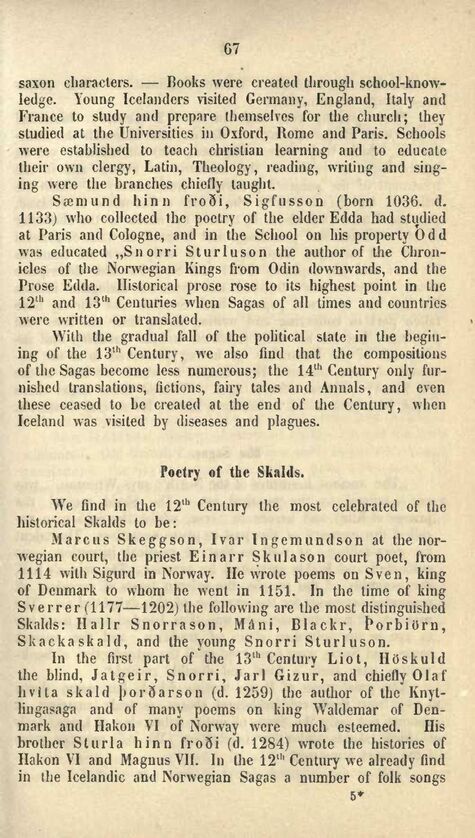
Full resolution (JPEG) - On this page / på denna sida - The Old Norsk Poetry and the Sagas

<< prev. page << föreg. sida << >> nästa sida >> next page >>
Below is the raw OCR text
from the above scanned image.
Do you see an error? Proofread the page now!
Här nedan syns maskintolkade texten från faksimilbilden ovan.
Ser du något fel? Korrekturläs sidan nu!
This page has been proofread at least once.
(diff)
(history)
Denna sida har korrekturlästs minst en gång.
(skillnad)
(historik)
anglo-saxon characters. — Books were created through
school-knowledge. Young Icelanders visited Germany, England, Italy and
France to study and prepare themselves for the church; they
studied at the Universities in Oxford, Rome and Paris. Schools
were established to teach Christian learning and to educate
their own clergy, Latin, Theology, reading, writing and
singing were the branches chiefly taught.
Sæmund hinn froði, Sigfusson (born 1036. [[** sic, iflg leks. 105!6 **]] d.
1133) who collected the poetry of the elder Edda had studied
at Paris and Cologne, and in the School on his property Odd
was educated [[** mgl. noe her? Minst et punktum? Hva gjør Odd relevant her?**]] „[[** hva er poenget med dette tegnet? Neste setning virker ukomplett **]]Snorri Sturluson the author of the
Chronicles of the Norwegian Kings from Odin downwards, and the
Prose Edda. Historical prose rose to its highest point in the
12th and 13th Centuries when Sagas of all times and countries
were written or translated.
With the gradual fall of the political state in the
begining [[** sic = -nn- **]] of the 13th Century, we also find that the compositions
of the Sagas become less numerous; the 14th Century only
furnished translations, fictions, fairy tales and Annals, and even
these ceased to be created at the end of the Century, when
Iceland was visited by diseases and plagues.
Poetry of the Skalds.
We find in the 12th Century the most celebrated of the
historical Skalds to be:
Marcus Skeggson, Ivar Ingemundson at the
norwegian court, the priest Einarr Skulason court poet, from
1114 with Sigurd in Norway. He wrote poems on Sven, king
of Denmark to whom he went in 1151. In the time of king
Sverrer (1177—1202) the following are the most distinguished
Skalds: Hallr Snorrason, Máni, Blackr, Þorbiörn,
Skackaskald, [[** kommaer sic **]] and the young Snorri Sturluson.
In the first part of the 13th Century Liot, Höskuld
the blind, Jatgeir, Snorri, Jarl Gizur, and chiefly Olaf
hvita skald Þorðarson (d. 1259) the author of the
Knytlingasaga and of many poems on king Waldemar of
Denmark and Hakon VI of Norway were much esteemed. His
brother Sturla hinn froði (d. 1284) wrote the histories of
Hakon VI and Magnus VII. In the 12th Century we already find
in the Icelandic and Norwegian Sagas a number of folk songs
<< prev. page << föreg. sida << >> nästa sida >> next page >>